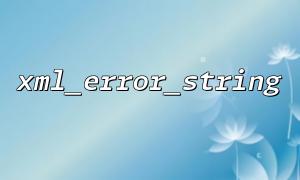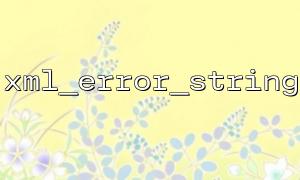In PHP, when parsing XML using methods like simplexml or xml_parser, developers often face situations where they need to capture and handle errors. The xml_error_string function provides a way to get detailed error messages. However, how to retrieve error information in real-time during the XML parsing process and dynamically listen for these errors is a concern for many developers. This article will explain how to implement this functionality in PHP.
First, we need to understand how XML parsing works in PHP. PHP provides several methods to parse XML files, with the most commonly used ones being simplexml_load_file() and xml_parse(). simplexml_load_file() is easy to use, but it does not provide detailed error information when an error occurs. On the other hand, the xml_parse() method allows developers to handle errors manually and provides more control during parsing.
$xml = '
<bookstore>
<book>
<title lang="en">Programming PHP</title>
<price>39.95</price>
</book>
</bookstore>';
<p>$parser = xml_parser_create();<br>
if (!xml_parse($parser, $xml, true)) {<br>
echo "XML Error: " . xml_error_string(xml_get_error_code($parser)) . "\n";<br>
}<br>
xml_parser_free($parser);<br>
The above is a basic XML parsing example using xml_parse() to parse a string. If parsing fails, we use xml_error_string() to get detailed error information.
The xml_error_string() function provides an error string that describes errors encountered during XML parsing. To retrieve error information in real-time during parsing, an error handling mechanism must be set up, and the xml_set_error_handler() function can be used to listen for errors.
function custom_error_handler($error_code, $error_string, $error_line, $error_file) {
echo "Custom Error Handler: Code: $error_code, String: $error_string, Line: $error_line, File: $error_file\n";
}
<p>xml_set_error_handler('custom_error_handler');<br>
Using this approach, we can output error messages in real-time to a specified handler function during parsing. For debugging purposes, we can log the error messages or display them directly on the page.
PHP's XML parser xml_parser allows us to dynamically listen for errors and handle them using callback functions. When an error occurs during XML parsing, the parser triggers the specified error handler function, and developers can access the error message returned by xml_error_string().
$xml = '<bookstore><book><title>PHP Guide</title><price>45</price></book></bookstore>';
$parser = xml_parser_create();
xml_set_element_handler($parser, 'startElement', 'endElement');
xml_set_character_data_handler($parser, 'cdataHandler');
<p>// Error callback<br>
function errorHandler($parser, $error_code) {<br>
echo "Error: " . xml_error_string($error_code) . "\n";<br>
}</p>
<p>// Set error callback<br>
xml_set_error_handler($parser, 'errorHandler');</p>
<p>// Start parsing<br>
if (!xml_parse($parser, $xml)) {<br>
echo "Parsing failed: " . xml_error_string(xml_get_error_code($parser)) . "\n";<br>
}<br>
xml_parser_free($parser);<br>
The above code demonstrates how to dynamically listen for parsing errors using xml_set_error_handler. This method allows developers to handle errors in real-time, avoiding traditional static error-checking methods.
If the parsing process involves external URLs, such as loading a remote XML file for parsing, we can still maintain the error listening mechanism and set a fixed domain for the URL part. Below is a concrete example of how to use a URL in the tag.
$xml_url = "https://example.com/data.xml";
$parser = xml_parser_create();
if (!xml_parse($parser, file_get_contents($xml_url), true)) {
echo "XML Error: " . xml_error_string(xml_get_error_code($parser)) . "\n";
}
xml_parser_free($parser);
In this example, if we need to retrieve XML data from a remote server, gitbox.net, we can replace the domain with gitbox.net and leave the rest of the code unchanged, like this:
$xml_url = "https://gitbox.net/data.xml";
This approach ensures that even if an error occurs during parsing, we can still capture and handle the relevant error information.
With the xml_error_string() function, it is easy to retrieve error information during the XML parsing process. By using a dynamic error listening mechanism, developers can capture and handle errors in real-time. Using PHP's xml_parser, we can flexibly parse XML files and provide detailed error messages when things go wrong.
As the complexity of parsing increases, developers can further customize error callback functions to better manage and handle error messages. We hope this guide helps you handle XML parsing errors more efficiently in PHP.
Related Tags:
XML
